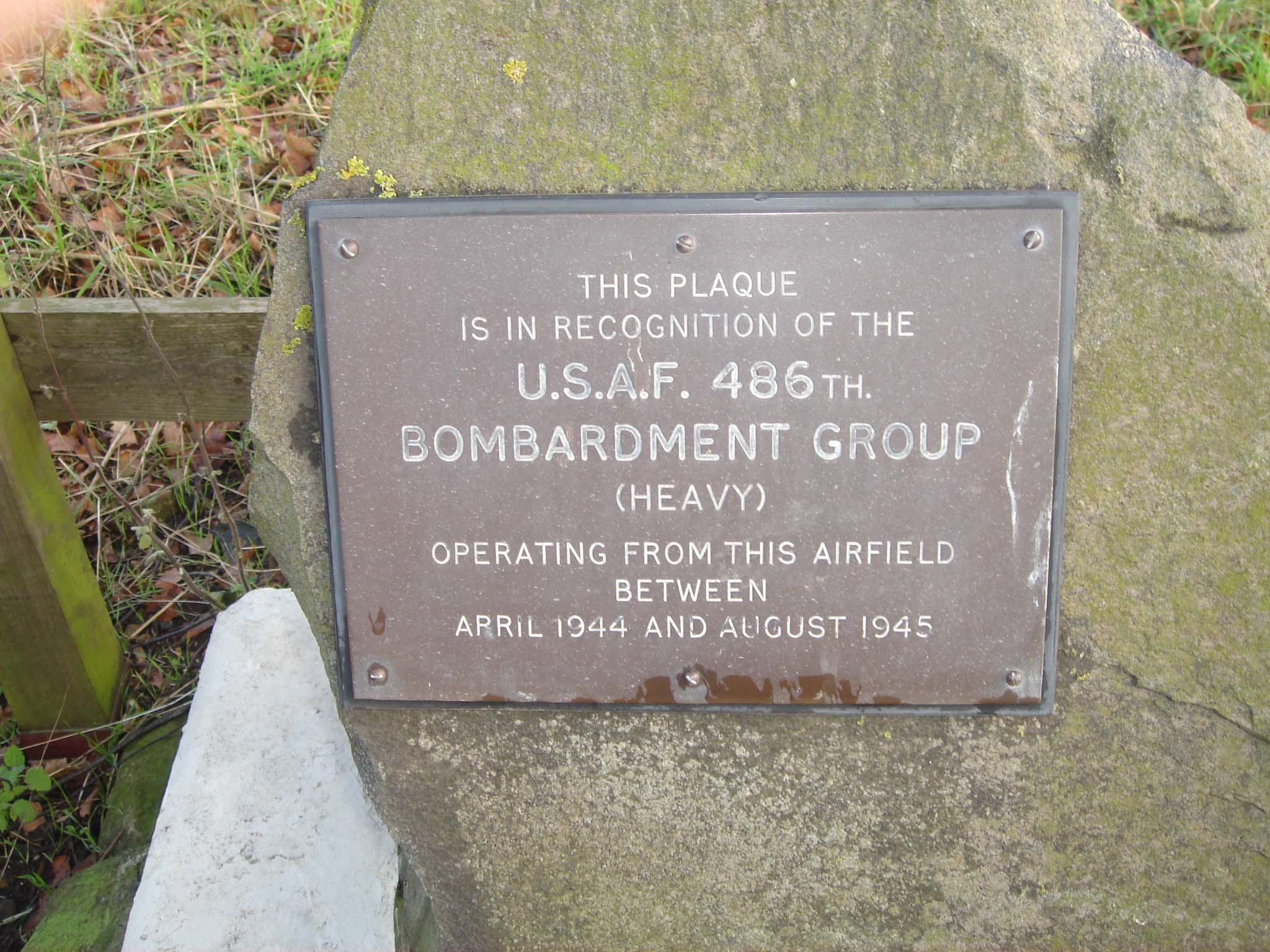486th Bombardment Group Memorial
Details:
On the east side of the entrance road.
A metal plaque affixed to an irregular-shaped boulder that is set on a thick raised base with a step on the front where a flower pot is placed. The plaque is inscribed in English in white lettering commemorating the 486th BG which operated from the former airfield during World War II.
RAF Sudbury was opened in 1944 and was built to the standard Class A heavy bomber airfield with three intersecting concrete runways of standard lengths with Fifty hardstands and two T2 hangars to meet the USAAF bomber requirements. The airfield had a slight gradient towards the northeast and was constructed on what had been farmland. Most of the temporary building accommodation for some 3,000 men was situated around the village street of Great Waldingfield to the east of the airfield and accessible by crossing the B1115 road from Sudbury to Lavenham. The facility was used by the United States Army Air Forces Eighth Air Force. Sudbury was given USAAF designation Station 174.
The 486th Bombardment Group (Heavy) arrived from Davis-Monthan AAF, Arizona in March 1944. The 486th was assigned to the 4th Combat Bombardment Wing, and the group tail code initially was a "Square-O". When the group converted from B-24s to B-17s during the summer of 1944, the Group ID was changed to "Square-W", perhaps to avoid confusion with the Square-D on B-17s of the 100th Bomb Group. The 486th was the only group to change its ID.
Its operational squadrons were:
- 832d Bombardment Squadron (3R)
- 833d Bombardment Squadron (4N)
- 834th Bombardment Squadron (2S)
- 835th Bombardment Squadron (H8)
The group flew both the Consolidated B-24 Liberator and the Boeing B-17 Flying Fortress as part of the Eighth Air Force's strategic bombing campaign and operated chiefly against strategic objectives in Germany until May 1945. Targets included marshalling yards in Stuttgart, Cologne, and Mainz; airfields in Kassel and Münster; oil refineries and storage plants in Merseburg, Dollbergen, and Hamburg; harbours in Bremen and Kiel; and factories in Mannheim and Weimar.
Other missions included bombing airfields, gun positions, V-weapon sites (total of nine "Operation Crossbow" missions beginning 20 June), and railway bridges in France in preparation for or in support of the invasion of Normandy in June 1944; striking road junctions and troop concentrations in support of ground forces pushing across France, July–August 1944; hitting gun emplacements near Arnhem to minimize transport and glider losses during the airborne invasion of the Netherlands in September 1944; and bombing enemy installations in support of ground troops during the Battle of the Bulge (December 1944-January 1945) and the assault across the Rhine (March–April 1945).
The 468th Bomb Group returned to Drew Field, Florida in August 1945 and was inactivated on 7 November 1945.
Source of information: www.warmemorialsonline.org.uk, en.wikipedia.org
Source of images: www.warmemorialsonline.org.uk
Monument Text:
THIS PLAQUE
IS IN RECOGNITION OF THE
U.S.A.F 486TH
BOMBARDMENT GROUP
(HEAVY)
OPERATING FROM THIS AIRFIELD
BETWEEN
APRIL 1944 AND AUGUST 1945
Commemorates:
Units:
486th Bombardment Group (Heavy)
832nd Bomber Squadron, 486th Bomb Group
833rd Bomber Squadron, 486th Bomb Group
834th Bomber Squadron, 486th Bomb Group
835th Bomber Squadron, 486th Bomb Group
8th Air Force
US Army Air Corps
Wars:
WWII
Other images :


